PinotFile: 7.5 November 2, 2008
|
Freestone VineyardsGrowing Pinot Noir along the most western reaches of the Sonoma Coast is a risky undertaking. The region is extremely cool and there is the constant threat of rain during bloom and harvest. Yields can be excruciatingly and unprofitably small, in some vintages totaling a 1/2 ton per acre, and in others, amounting to no commercially viable crop at all. The terrain is rugged and much of the land is inhospitable and unsuitable for vines. Gophers, birds, deer, and wild hogs are in abundance. Despite these obstacles, a dedicated few have accepted the challenge knowing that the fickle grape feels right at home here. Noted wine writer, Matt Kramer, has said, “One thing is already clear: Sonoma Coast West is an extraordinary location for Pinot Noir. Sonoma Coast West has the capacity - although not yet the achievement - of someday creating America’s grand cru Pinot Noirs.” The Sonoma Coast appellation (AVA) is the largest of the thirteen AVAs in Sonoma County at 750 square miles. This unwieldy appellation was formed in 1987 and includes an endless number of microclimates all typified by coolness. The Sonoma Coast AVA was primarily created to allow certain wineries to include all of their diverse vineyard holdings within one appellation so they could use the “estate bottled” designation on their wine labels. The Sonoma Coast AVA extends from the Sonoma County border with Napa Carneros to the East, to Marin County to the South, to the Pacific Ocean to the West, and to the Sonoma County border with Mendocino County in the North (see below).
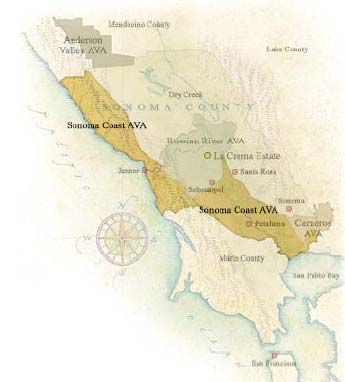 Because of the immensity of the Sonoma Coast AVA, an unofficial subdivision has been created termed the “true” Sonoma Coast (what Matt Kramer calls Sonoma Coast West). This subdivision is roughly from Jenner in the South where the Russian River empties into the Pacific Ocean, to Annapolis in the North, and from the beaches to 5 to 6 miles inland including the first two ridges of the Coastal Range of mountains and the western slope of the third ridge. Besides Annapolis and Jenner, Ft. Ross, Occidental and Freestone are included, although all are south of Jenner. At some point in the future, the true Sonoma Coast will be broken into smaller AVAs. Freestone Vineyards was not the first to plant Pinot Noir in the true Sonoma Coast. That honor goes to Mike Bohan. In 1973, he developed a vineyard on Bohan Dillon Road which included Zinfandel, Pinot Noir, Chardonnay and Riesling. Many others soon followed, notably David Hirsch (Hirsch Vineyard) and Walt and Joan Flowers (Camp Meeting Ridge), but also Helen Turley and John Wetlaufer (Marcassin), Lee Martinelli (Martinelli), Bill Smith (W.H.Smith), Daniel and Marian Schoenfeld (Wild Hog), Mark Bixler and Steve Kistler (Kistler Vineyards) and Marimar Torres (Marimar Estate). More recently, several prominent Napa wineries have developed vineyards in the true Sonoma Coast, including Caymus (Belle Glos), Pahlmeyer, Peter Michael and Joseph Phelps (Freestone Vineyards). Freestone Vineyards is clearly the most ambitious project and the only Napan producer to establish a winery and guest center in the true Sonoma Coast. The town of Freestone dates to the Gold Rush era in California, a time when Pinot Noir first arrived in California from cuttings imported by either Frenchman Pierre Pellier, Hungarian Colonel Agoston Haraszthy, or Frenchman Charles Lefranc. Freestone was named in 1853 after a quarry of sandstone in the area. The first white settlers in this area, James McIntosh, James Dawson and James Black, were sent by General Vallejo to settle the land near Freestone in the mid 1800s. The settlement was part of the Mexican government’s attempt to extend Mexico’s frontier in Sonoma County north toward the Russian settlement at Ft. Ross. By 1872, Freestone had become a terminus for the North Pacific Railroad and a trade center for the area. The photo below shows the North Pacific Coast Railroad’s Freestone Station as it looked in the 1900s.
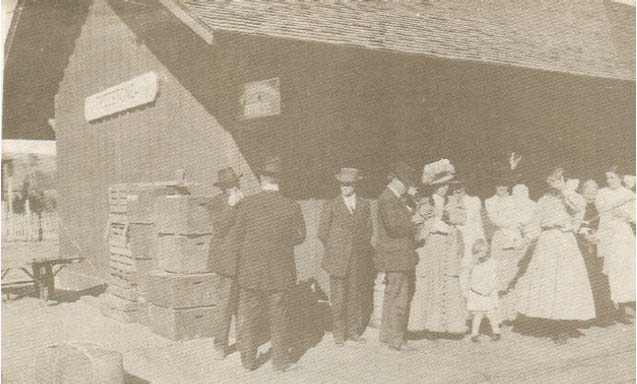 The once-thriving lumber industry eventually dwindled and the railroad was abandoned. This tiny town still has the original 1887 school house and the post office operates in what was originally the town’s general store. In 1974, Freestone was declared a historical district by the citizenry of Sonoma County. Freestone has become known mainly for two businesses. The Wild Flour Bakery at the intersection of the Bohemian Highway and Highway 12 bakes breads in a wood-fired brick oven that are among the best in Northern California. The nearby Osmosis is a world-renowned healing sanctuary and spa in a Japanese-style setting on five acres. Freestone Vineyards has brought new life to this sleepy town and undoubtedly will attract visitors who are curious about this westernmost frontier of Sonoma County Pinot Noir country. The Joseph Phelps organization has built a magnificent 40,000 square foot winery at the end of Freestone Flat Road. Bermed into the hillside and employing gravity-flow by way of its three level construction, it sits in the center of the estate Freestone Vineyard. Unfortunately, environmental concerns prevent tastings and tours at the winery, so Freestone Vineyards has opened an attractive and comfortable guest center at the corner of Bohemian Highway and Highway 12 in the historic Pastorale Building which was formerly a woolens store (see photo below). The inviting space is furnished in country French furniture and offers the visitors an appealing copper-topped bar or a spacious table to sit and linger. The entire project initially met with some resistance from local residents, but Freestone Vineyards has proven to them to be committed to being an attentive caretaker of this historically rich area.
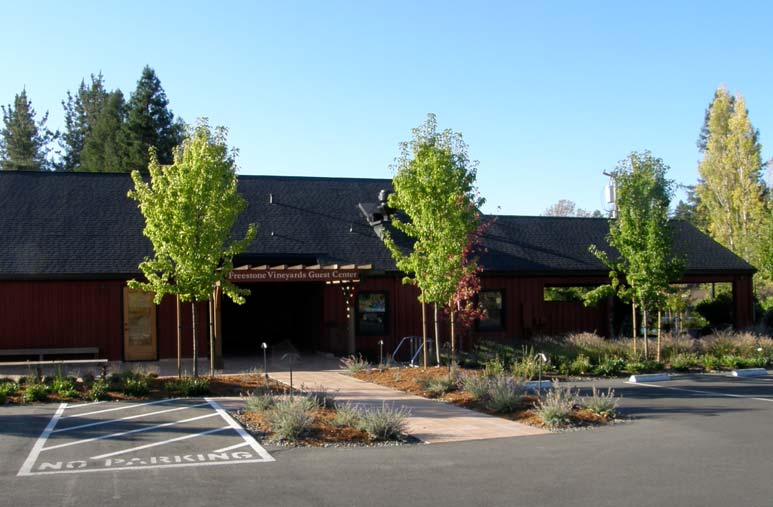
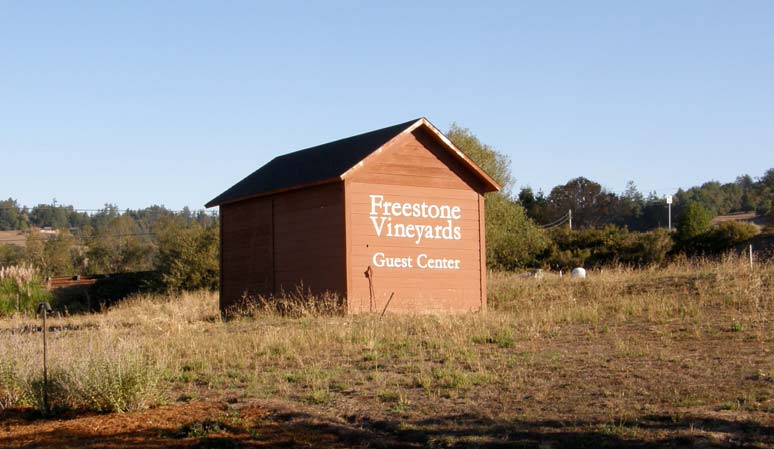
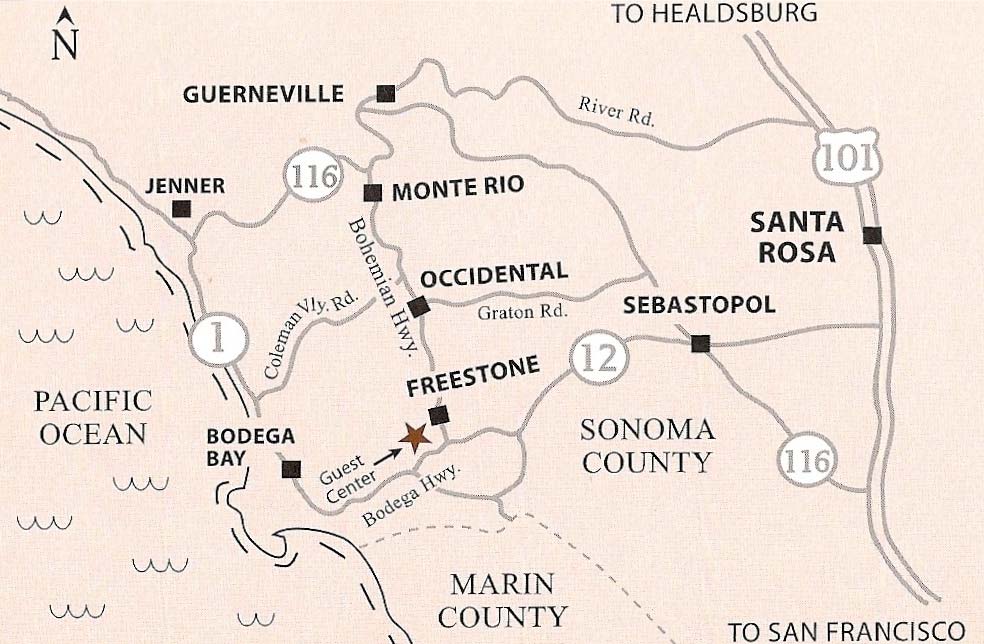 I visited Freestone Vineyards on a brilliantly sunny day in late October. Harvest had concluded but the vines were bursting with vibrant colors of orange and yellow, a striking contrast to the hillsides covered with towering redwood trees. I was met by a warm and enthusiastic staff, eager to show off their beautiful vineyard setting, modern winery, and superb wines. An impressive team has been assembled. Joel Robledo is the Vineyard Surpervisor, a veteran of 13 years in Knights Valley for Beringer and 3 years in Sonoma County for Joseph Phelps Vineyards. Vineyard Operations Manager Greg Cannon has experience working at numerous wineries in California and South Africa and has been at Joseph Phelps Vineyards since 1994. He has prime upstairs office space overlooking Pastorale Vineyard (the portion of Freestone Vineyard next to the winery and business center). The Cellar Master is Justin Ennis, a veteran of Williams Selyem Winery in Healdsburg, Villa Maria Winery in New Zealand and Vinas de Tupangato in Argentina. The winemaking team consists of Director of Winemaking Damian Parker, who has been with Joseph Phelps Vineyards since 1981 and Associate Winemaker Theresa Heredia. Theresa has an impressive educational resume, with a Bachelor’s degree in Biochemistry from Cal Poly in San Luis Obispo, and three years of study in the Chemistry and Viticulture/ Enology program at University of California Davis. Her winemaking experience includes time spent at Saintsbury in Napa Carneros and Burgundy. She joined Joseph Phelps Vineyards in 2002. This is a compatible pairing (the two are pictured below at the estate Quarter Moon Vineyard), with Damian providing the steadying and experienced hand and Theresia contributing the innovative enthusiasm of youth. Pascal Marchand, an internationally acclaimed winemaker and former manager of Domaine de la Vougeraie and the estate of Comte Armand, Domaine des Epeneaux, has brought his expertise as a consultant as well.
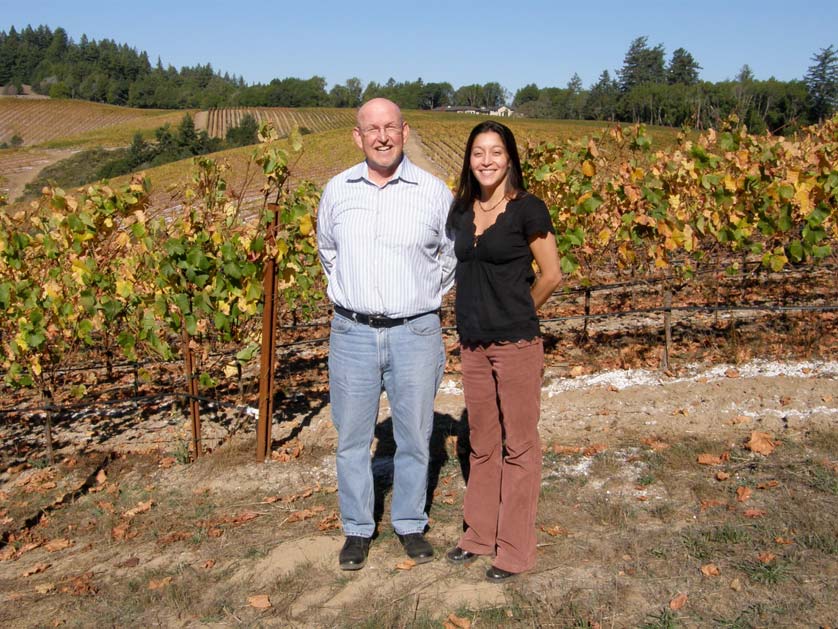 Freestone Vineyards dates to 1999, when Joseph Phelps, his son Bill and the Phelps management team bought 55 acres in Freestone on Freestone Flat Road. Joseph Phelps, who was fond of Chardonnay, had yearned for an appropriate location to establish a new Chardonnay program. His popular Joseph Phelps Ovation Chardonnay was sourced from vineyards in Carneros. The Freestone property, which in the past had been used for logging, dairy farming and even a rest home, was also a perfect locale for Pinot Noir. In 2000, additional nearby land was acquired including Quail Hill Ranch (renamed Quarter Moon Vineyard).
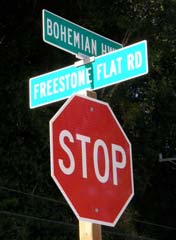 Planting began in 1999, divided among two sites. Freestone Vineyard consists of 60 acres of Pinot Noir and 20 acres of Chardonnay planted at elevations of 200 to 500 feet. This vineyard is divided into a north and south portion with most of the entire vineyard planted to 4’ x 4’ spacing. There is a diversified mix of rootstocks and clones (Calera and Swan selections, Dijon 115, 667, 777, 828 and the rarely planted 459). Generally, different blocks from this vineyard are vinified separately rather than isolating different clones and selections. Whole cluster fermentation is employed for blocks that are particularly suitable. The Freestone Vineyard and winery are pictured below with the North portion in the foreground and the South portion (recently named Pastorale Vineyard) in the distance surrounding the winery.
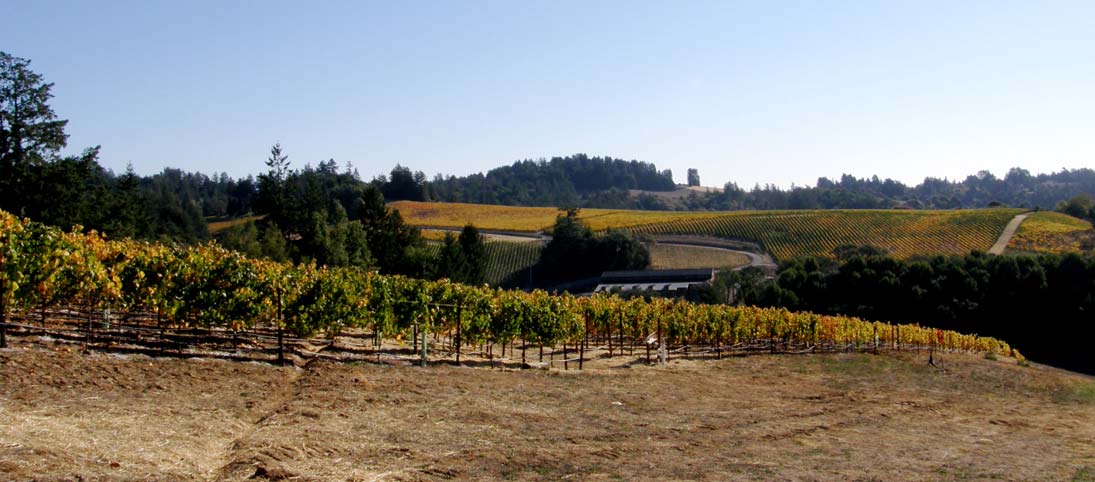 The nearby Quarter Moon Vineyard is located on the western side of Bohemian Highway and is planted to 40 acres of Pinot Noir. At 400 foot elevation at its highest, this vineyard lies above the fog line, facing south, and sits about five miles from the Pacific Ocean. It is in proximity to vineyards owned by Benziger and Kistler and is a magnificent site as you can see in the photo below. The plantings at Quarter Moon Vineyard include heritage selections (primarily Calera) as well as Dijon 115, 777 and 828.
 A third vineyard source, the Ferguson Vineyard, consists of six acres of Pinot Noir planted to Dijon clone 115. The fruit is sourced under a 30-year lease from the owners. All the vineyards are exposed to chilly maritime air with low-lying morning fog giving way to afternoon sunshine. Temperature swings of 45 degrees are not unusual and the cool days of the spring growing season can lead to low berry set. Farming here is not for the faint-of-heart. Soils are Goldridge Series with excellent drainage. Roots grow deeply searching for nutrients, allowing some vineyard blocks to be dry farmed. Ultimately, it is hoped that all Freestone vineyards will be dry farmed and managed biodynamically. Controlling weeds and gophers continues to be an “uphill battle” as Theresia notes, and requires constant vigilance. The modern winery, completed in time for the 2007 harvest, is a state-of-the-art, gravity-flow facility enabling the winemaking staff to perform at the highest level. Designed by architect Paul Smith, who created the design at Byron Winery in the Central Coast, the winery was built by Hansel Phelps Construction in Colorado. Joseph Phelp’s father, Hensel, founded this company in 1937 and Joseph ran it for many years before departing to enter the wine industry in the early 1970s. The winery’s hillside location and compatible exterior blends perfectly into the wooded location. Inside, the facility is all concrete, stainless steel and copper, and roomy enough to be highly efficient. An industrial lift provides easy movement of winery equipment and byproducts of winemaking between the three levels. On the upper floor, a refrigerated holding room keeps incoming bins of fruit cold so that bright fruit flavors and acidity are retained before processing. Cold grapes can also be destemmed more readily. The center level houses 35 4 1/2- to 7-ton stainless steel fermenting tanks. Five wood tank fermenters permit more focused winemaking for primarily the vineyard designate bottlings. The lower level features separate temperature-controlled barrel rooms for Chardonnay and Pinot Noir. Winemaking with Freestone fruit is still evolving. The vines are very young and 2006 is the first large-scale commercial vintage. In 2002 and 2003, a few barrels of wine were produced and in 2004 and 2005, a FogDog Pinot Noir blended from grapes from the three estate-grown vineyards was released. Theresa noted that tannin management has been one of her major focuses since the Freestone grapes typically show sturdy tannin development. Noted winemaker Ted Lemon has characterized true Sonoma Coast Pinot Noir as, “Muscle and sinew, grit, structure, more backbone and tannin than Russian River Valley Pinot Noir.” Theresa has adjusted stem inclusion, maceration, the temperature of fermentation, and the pigeage regimen searching for the ideal combination to soften tannins. Currently, she is incorporating more stems, macerating and fermenting at a higher must temperature, extending maceration, and adding two punch overs a day to the punch down program. The oak regimen calls for light to medium toasted French oak barrels and 40-60% new oak, with the highest proportion of new oak reserved for the vineyard-designate Pinot Noirs. Filtration is avoided completely and fining is employed only rarely. At the winery, I tasted the 2006 Fogdog and 2006 Freestone Pinot Noirs, which are now in release, and two vineyard-designates, the 2007 Quarter Moon Vineyard and 2007 Pastorale Vineyard Pinot Noirs, scheduled for future release. The 2006 Pinot Noirs along with the Chardonnay lineup were re-tasted in my usual setting at home. The Chardonnay program is on equal footing qualitatively with the Pinot Noirs. The true Sonoma Coast has not received the same recognition for Chardonnay as for Pinot Noir but considerable potential has been shown by releases from Hirsch, Marcassin, Sonoma Coast Vineyards and now Freestone Vineyards. Given the impressive wine program at Freestone Vineyards, and the considerable financial backing, I was not surprised to find the entire lineup of wines stellar. However, the wines exceeded my expectations and I believe this new producer is poised for greatness. The wines of Freestone Vineyards are confirmation that Matt Kramer’s quote is not just hyperbole. The 2006 vintage on the Sonoma Coast was characterized by rain and plenty of it (more than 9 feet). The result was an extended growing season with late but adequate ripening.
2007 Freestone Vineyards Pastorale Vineyard Sonoma Coast Pinot Noir 14.0% alc., 50 cases, $90-$100 when released. Wood tank and whole cluster fermented, aged in 60% new French oak. 98% Calera selection from the Pastorale Vineyard (formerly part of the Freestone Vineyard, this is the estate vineyard that surrounds the winery). · A confected cherry nose leads to a rich and full dark fruited wine with an earthy edge. Nicely spiced and oaked with chewy tannins and great depth. Still a puppy.
2007 Freestone Vineyards Quarter Moon Vineyard Sonoma Coast Pinot Noir 14.0% alc., 50 cases, $90-$100 when released. Wood tank fermented, 67% whole clusters. Clones 777 and 828. · This is a striking Pinot that is at once both rich and silky, featuring earth-dusted red fruits, refined tannins, lively acidity and a fresh, clean mouth feel. The finish is outrageous, struting a peacock tail of flavor of uncommon intensity. I can’t wait to get my hands on this one.
2006 Fogdog Sonoma Coast Chardonnay 14.0% alc., 1,400 cases, $40. Exclusively from estate-grown vineyards. Fogdog refers to a bright clear spot that appears in breaking fog. Fermented in stainless steel, aged 12 months in 50% new French oak barrels. · Pale yellow in color. A very similar flavor profile to the winery’s Freestone Vineyards Chardonnay but with less intensity and lacking the same textural appeal. Still, it is a very good wine that woman will love. Attractive scents of butter, white fruits, citrus, vanilla and smoke are echoed in the flavors. Rich with leesy notes as well and blessed with admirable acidity on the tasty finish. Freestone Chardonnay in a skirt.
 2006 Fogdog Sonoma Coast Pinot Noir 13.5% alc., 3,400 cases, $40. A blend from all three of the estate-grown vineyards. A mixture of Dijon and heirloom clones. Aged 12 months in 40% new and 60% two to three-year-old French oak barrels. Whole berries were maximized and a small number of whole clusters employed. · Aromas of well-spiced cherries with a touch of smoke. Satisfying in the mouth with impressive grip. The flavors of cranberries and sour cherries are enhanced by a bracing tang of citrus. Tannins are well integrated and the refreshing finish begs for another sip
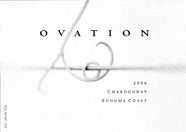 2006 Ovation Sonoma Coast Chardonnay 14.0% alc., 700 cases, $60. Sourced from Freestone and other Coast growers. 100% barrel fermented, native yeast fermentation, aged in 70% new French oak barrels for 12-15 months, unfined and unfiltered. Replaces the Joseph Phelps Vineyards Ovation Napa Carneros Chardonnay which was discontinued in 2004. · Flavors of pear, 7-Up and fig in a crisp, clean and brightly styled Chardonnay imbibed with minerality and unburdened by oak. Akin to a fine blanc de blanc Champagne without the bubbles. Excellent.
2006 Freestone Vineyards Sonoma Coast Chardonnay 13.5% alc.,700 cases, $75. 100% estategrown Chardonnay from Freestone Vineyards. Aged 15 months in 70% new and 30% one to two-yearold French oak barrels. · Pale blond in color with a touch of gold. This wine is Fogdog’s sculpted big brother. Bold aromas of buttered popcorn, yeast, toasted oak and white stone fruits lead to delicious and moderately intense flavors of white peach and pear with a charming mineral note. Slightly viscous on the palate and very clean on the finish. This has all the attraction of barrel fermented Chardonnay, yet enough sophistication to charm even the most hard core white Burgundy lover. I could drink this all night long.
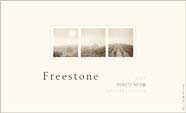 2006 Freestone Vineyards Sonoma Coast Pinot Noir 14.0% alc., 2,700 cases, $75. 100% Sonoma Coast Pinot Noir from estate Freestone and Quarter Moon Vineyards. Primarily Dijon clones with some heirloom selections. Aged 15 months in 55% new and 45% two to three-year-old French oak barrels. Whole berries were maximized and some whole clusters were included. This Pinot Noir represents a selection of the best wines produced during the 2006 harvest. · Very lovely and pure aromatics featuring dark red berries and stone fruits infused with herbs, and subtle oak toast and spice. A charming and demure wine on the palate that is silky and supple with understated but satisfying red and black fruit flavors complimented by deft use of oak progressing to a persistent and memorable finish of spiced fruit and orange peel. The wine’s balance is impeccable portending a long life ahead. This Pinot Noir drank beautifully the following day from a re-corked previously opened bottle, exhibiting more spice, mocha and coffee notes and a very sexy velvety texture. This wine may not have the levels of complexity that future vintages will flaunt as the estate vines age, but it remains an impressive wine.
Freestone Vineyards Guest Center is located at the intersection of Bodega Highway (Highway 12) and Bohemian Highway at 12747 El Camino Bodega in Freestone. It is currently open from 11:00 to 5:00 Friday through Sunday. Pick up some cheese in Santa Rosa, only thirty minutes away, grab some bread at nearby Whole Flour Bakery, and relax at the Guest Center over some welcoming wines. Both indoor and outdoor tables are available. Children and dogs are welcome. Special private events may be held at the facility. The Freestone Vineyards Private Collection allows members access to new releases of Chardonnay and Pinot Noir as well as limited production wines which are available to members only. Members receive preferred pricing and invitations to private, members-only events. Visit the website at www.jpvfreestone.com or phone 707-874-1010. The Fogdog wines and Ovation Chardonnay are distributed through retail channels, and the more limited Freestone Vineyard wines are sold primarily through a mailing list, to Freestone Vineyards Private Collection members and directly to visitors at the Guest Center.
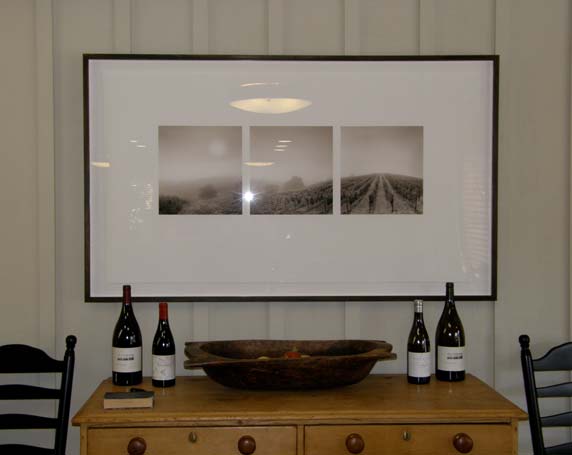
Littorai Now Receives VisitorsRegular readers of the PinotFile realize that I have the upmost respect and admiration for Ted Lemon, proprietor and winemaker at Littorai. For many years, Ted has made the long trek from his home in Sebastopol to Angwin in Napa County, where he has crafted his wines. Ted has always been receptive to visitors, but few made the attempt to see him in the mountainous outpost of Angwin and as a result, his notoriety has primarily been shared by those in the know in the wine business. A new winery facility has been a goal of Littorai Wines since inception in 1993 when 12 barrels were crafted in the back of Robert Pecota Winery. Ted has now completed construction of an innovative, environmentally sensitive winery on his personal estate in the western hills of Sebastopol. Located on 30 acres of rolling hills on a ridge top in the Sonoma Coast AVA, Littorai’s new winery incorporates straw bale construction and incorporates gravity flow on its two levels. The lower level is bermed into the hillside. The straw bale walls insulate the winery so that a cooling temperature is maintained naturally in all but the barrel storage area. When I visited recently on a warm afternoon, the winery temperature inside was 65°F. In the future, caves will be built connecting to the winery, allowing for all natural cooling throughout the facility. All the process waste from winemaking is recycled through a constructed wetlands system and recycled for vineyard and property irrigation. Natural lighting is employed with strategically placed windows reducing the need for electricity. The estate Pinot Noir vineyard on the property is farmed biodynamically using only organically certified materials and the farm is integrated, diversified and selfsustaining. Photos of the new winery and estate vineyard are included below. The recovery pond (still under construction) and large compost pile in the distance are visible in the lower right photo.
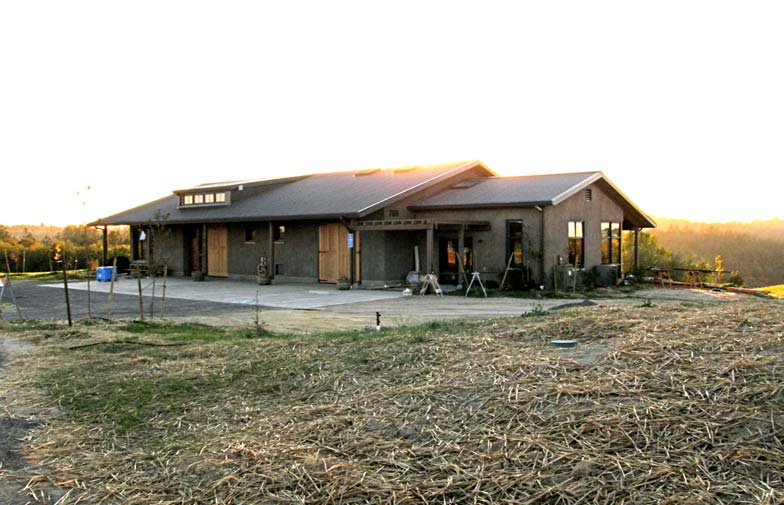
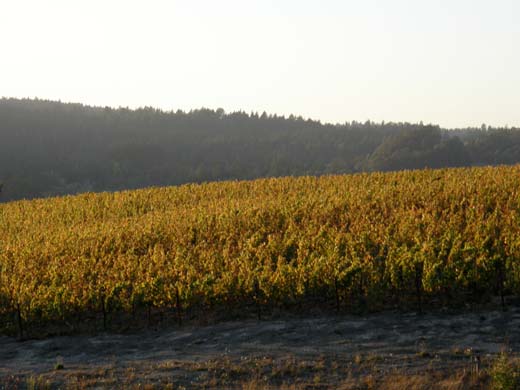 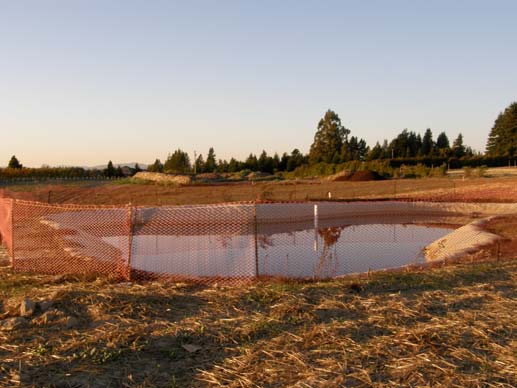
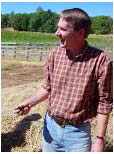 Ted and I chatted about the challenging 2008 harvest. Heat forced Ted to pick grapes in some sites earlier than he would have preferred, forcing him to discard 4% of the crop on the sorting table. In some locations, an additional two weeks of hang time was possible and that made all the difference with those grapes coming in more uniformly ripe. His early consensus about the vintage was that the wines have plenty of color and concentration, yet are not particularly tannic. Ted has been farming many of his leased vineyards biodynamically since 2001. Beginning with the 2008 vintage, 90% of Littorai’s vineyard sources will be farmed using only organically certified materials. 54% will be farmed biodynamically and 39% of the wines will be estate production. Ted feels strongly that “wine from a well managed biodynamic vineyard expresses terroir like no other.” In addition, Ted has found dry farming to be preferable although not possible at all sites. Thieriot Vineyard and the older vines at Summa Vineyard are now dry-farmed and Hirsch is close. The Haven is in a cooler region and can be dry farmed as the vines age. Cerise Vineyard in the Anderson Valley is very dry and rocky and must be irrigated. Dry farming is not an absolute for most vineyards since some dry vintages such as 2006 (see next paragraph) require some irrigation.
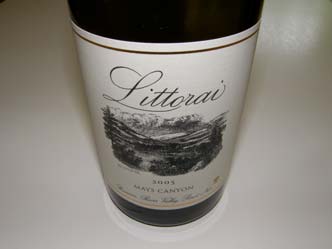 I tasted through several of the 2006 vintage wines that were open. Ted summarized the vintage for me. 2006 was dry with no rain after April 15th, requiring irrigation in all vineyards. Botrytis was prevalent at most Chardonnay vineyards and even at some Pinot Noir vineyards caused by the dense fog in late summer. Because of generally cool weather, seed maturity and lignification were both excellent before harvest (always a positive sign for wine quality). The 2006 Littorai Pinot Noirs are aromatically fruit and flower wines with low tannins and are very approachable young. They are generally more charming than their more woodsy 2005 brethren. The Chardonnays required vigorous sorting to discard botryitized fruit. They are fresh and lively wines, more feminine and elegant than the 2005 vintage with a higher acidity impression. The 2006 Cerise Vineyard Anderson Valley Pinot Noir had been open for two days and was spectacular showing plenty of lush fruit with supple tannins. This wine can be quite masculine, sinewy and earthy, but the additional air time softened the hard edges. The 2006 Hirsch Vineyard Sonoma Coast Pinot Noir had been open for two days as well and it is starting to come around sporting juicy berry flavors and lively acidity. The 2006 The Haven Sonoma Coast Pinot Noir had only been open a few hours, yet was very appealing with charming dark fruit flavors and a velvety texture. The 2006 Savoy Anderson Valley Pinot Noir had been open for a day but it is clearly not ready. It was very reserved and angular with plenty of acidity to the forefront. Ted’s Chardonnays are perfectly weighted with precise flavors and impeccable balance. You never think oak or alcohol when drinking Ted’s wines. The 2006 Heintz Vineyard Chardonnay showed juicy pear and citrus flavors with plenty of grip. The 2006 Theiriot Vineyard Sonoma Coast Chardonnay was really a charmer, attractively layered and textured, with a perfect balance between white stone fruits and acidity. Surprisingly, all the above Littorai wines are still available for purchase from the winery. Tours and tasting at Littorai are available by appointment by contacting Ted’s assistant, Tami, at tami@littoraiwine.com or phoning 707-823-9506. Customers can now pick up their wine at the winery instead of having it shipped. For those reading this issue in time, an Open House will be held November 8th including tasting of current releases and library wines from the cellar (reservations required). Listen to my interview in 2007 with Ted Lemon that has been posted on Grape Radio: www.graperadio.com/ archives/2007/07/30/ted-lemon-and-the-wines-of-littorai.
Davis Bynum Leaves Russian River Valley Legacy to New GenerationDavis Bynum sold his eponymously named winery last year but his legacy will live on in the memory of pinotphiles. Davis Bynum Winery was the first winery on Westside Road, now the Rodeo Drive of Pinot Noir, and the first winery to produce a single vineyard Pinot Noir from the Russian River Valley - the 1973 Davis Bynum Winery Rochioli Vineyard Russian River Sonoma County Pinot Noir. Bynum wanted to duplicate the French appellation system and bring attention to the source of the grapes in his wines. Wine labels displaying the appellation origin have become the standard in the United States and is now required by law for all grape wine labeled with a grape varietal designation. A young self-taught winemaker, Gary Farrell, was a friend of Davis’ son, Hampton, and made his first Pinot Noir for Davis Bynum as an assistant to Davis Bynum in 1978. He stayed on as winemaker for 20+ years and continued to consult when he started his own eponymous winery on Westside Road. Throughout his winemaking career, Davis Bynum always sought to emphasize varietal character and food friendliness in his wines, undoubtedly influenced by his father who was a wine writer and wine judge and his involvement in the food and wine scene in the San Francisco Bay Area before founding Davis Bynum Winery. Lindley Davis Bynum Jr. (he dropped the Lindley as a teenager) was born and raised in Southern California. He was a bright youngster who entered Stanford University after high school, only to drop out to enter the Army. After his stint in the service, he became interested in wine, fueled by his father’s passion for wine and the frequent father and son trips they shared to wineries. Bynum subsequently graduated from University of California Berkeley and began making wine at home in 1951. The story goes that he bought some Petite Sirah grapes from Robert Mondavi to make his first wine. While working as a reporter and editor at the San Francisco Chronicle, he became immersed in the local wine culture and in 1965, converted a warehouse in Albany into a small garagiste winery. He learned his winemaking primarily through information that was available at the University of California Berkeley library. He was able to obtain grapes and bulk wine for several years from Louis Martini and August Sebastiani, among others, and made his first Pinot Noir in 1969. The wines produced in Albany were released under the name Barefoot Bynum. There are two stories circulating regarding the origin of the name. It has been written that when Davis’ father retired and bought a vineyard in the Napa Valley, his friends kidded him that he would be producing “Barefoot Bynum Burgundy.” The other story, on the current Barefoot Wine website, says that Davis’ father needed a name for the wines he would possibly make from his vineyards and he came up with name Barefoot Bynum referring to the historic method of making wine by crushing grapes barefoot. Either way, Davis used the name when his father relented and the Barefoot brand of jug wines became hugely popular. Davis always resented the Barefoot Bynum label for it outsold his high-end Davis Bynum label and he finally phased the brand out when he closed his Albany facility in 1973. The Barefoot label is now part of the E.&J. Gallo Winery portfolio. By 1971, it had become increasingly difficult for Davis to acquire suitable grapes and he was outgrowing his limited facilities. His drive to own a winery led him to acquire a 26-acre vineyard in the Napa Valley. Local zoning regulations at the time prevented him from refurbishing the winery on the St. Helena property, so he turned his attention to the Russian River Valley which was more receptive to newcomers. He bought the 84- acre River Bend Ranch at 8075 Westside Road in 1972 for a reported $115,000. Until the 1950s, the Russian River Valley was a prime growing region for hops, and several properties, including the River Bend Ranch, had hop kilns where the hops were dried. Bynum converted the hops processing room next to the kiln to a winery and Davis Bynum Winery was born. Bynum developed a number of handshake agreements with local growers such as Joe Rochioli, Jr., Howard Allen, and Rick Moshin, many of which persisted until he sold the winery last year. He started with Rochioli Vineyard Pinot Noir grapes in 1973 and for years he was the only winery that Rochioli sold to. In 1990, Davis planted 9 acres of Pinot Noir on a hill above the winery and named it Lindley’s Knoll. The Davis Bynum Winery tasting room retained a rustic appeal through the years and was a popular spot for visitors to the Russian River Valley wine country. Production at Davis Bynum was about 8,000 cases annually of several varieties, but Pinot Noir was always associated with the Davis Bynum label. Davis, now in his 80s, sold the Davis Bynum brand and inventory of wine to Tom Klein and the Klein family, owners of Rodney Strong Vineyards in the Russian River Valley in August of 2007. Rodney Strong Vineyards will bottle a Pinot Noir and Chardonnay under the Davis Bynum name. Reportedly, Davis Bynum will remain as a consultant for Rodney Strong for three years. The former Davis Bynum Winery and estate vineyards were acquired by the Baker family of Toronto, Canada who had longed to enter the wine business. I visited the property recently and met up with Jeremy Baker who was directing the renovation and refurbishing of the winery, tasting room and vineyards. Jeremy Baker was involved in the restaurant wine importing business in Toronto before taking the reigns as President of the new winery, named Thomas George Estates. I was impressed by the ambitious improvements being instituted on the property. The exterior and interior of the old winery have been updated and new winemaking equipment, including a basket press and stainless steel fermenters, have been installed for the 2008 vintage. The winery is being expanded to allow all grape processing and winemaking to be under roof. Initially production will be about 5,000 cases annually, increasing in a few years to 16,000 cases per year.
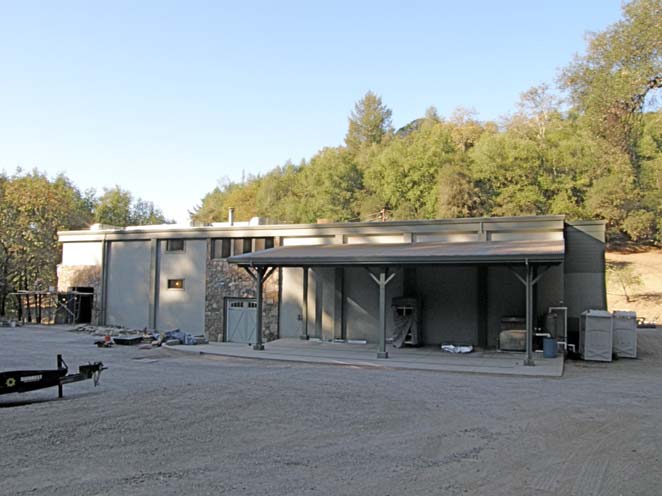 The tasting room is being completely upgraded, yet still retaining its original location and some of its country charm. The 20-acre Lindley’s Knoll Vineyard is undergoing revitalization with replanting of 10 acres under the direction of noted viticulturalist Ulyses Valdez. Eventually the estate vineyard will consist of 24 acres of Pinot Noir and 4 acres of Chardonnay. A small Viognier vineyard is being planted along the entrance road to the winery. New landscaping is creating attractive outdoor picnic areas. The Bakers have purchased the 26-acre Starr Ridge Vineyard on Windsor Road and the 14-acre Cresta Ridge Vineyard in the Green Valley appellation, both premium sources of Pinot Noir. Contracts with several growers such as Windsor Oaks Vineyard will supply further grapes. Gary Farrell and Guy Davis (Davis Family Vineyards) have been on site to consult. The new winemaker, Chris Rossi, is a University of California Davis graduate who recently left an eight year stint as winemaker at Christopher Creek. He has a background in vineyard management as well as winemaking. Like the Bakers, he also is young and enthusiastic and I like what he has accomplished in his short time (one vintage) here. I tasted several 2008 Pinot Noirs from barrel and they were impressive. Some wine was made in 2007 by a different winemaker and plans are to release it when the winery officially opens in January, 2009. There is clearly enough financial backing to insure this new venture is a success and it is reassuring to see that the Davis Bynum legacy is in the good hands of the current generation. Thomas George Estates will be a significant new addition to the lineup of prestigious wineries dotted along Westside Road, the Rodeo Drive of Pinot Noir.
References for the Davis Bynum profile: Wine & Viticulture History of Region Known as the Russian River Valley Appellation, William F. Heintz, 1999; Great Winemakers of California: Conversations with Robert Benson, 1977; Davis Bynum. A Creative Wine Pioneer. An Oral History. Interviewed by Carole Hicke, 2001-2003.
Fog Makes Pinot in the Russian River ValleyIt is only a three letter word, but fog is the defining characteristic of the Russian River Valley appellation. Many cool winegrowing regions of California now emphasize the important role fog plays in proper development of grape flavors, but it was the Russian River Valley appellation that first used fog intrusion as its most differentiating feature. The regular ebb and flow of fog originates from the Pacific Ocean a few miles to the West and enters the Valley primarily through the Petaluma Wind Gap and secondarily along the channel created by the Russian River that empties into the Pacific Ocean at Jenner. The fog arrives in the evening, frequently dropping the temperature 40 degrees from its daytime high and then retreats the following morning. This maritime air conditioner extends the growing season and allows grapes to reach full flavor maturity while retaining natural acidity.
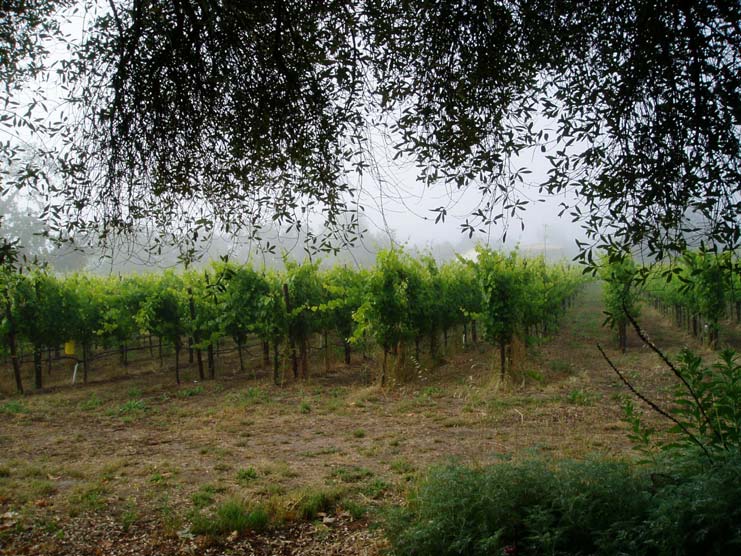 The Russian River Valley American Viticultural Area (AVA) was approved in 1983. The original boundary lines were subsequently amended to include additional areas influenced by coastal fog. Currently, the Russian River Valley AVA consists of 198 square miles and includes 15,710 total acres of vineyards. It is one of 13 AVAs contained in Sonoma County. The AVA includes more than 200 growers and nearly 100 wineries. For an accurate map of the boundaries of the Russian River Valley AVA, consult the map located on the Russian River Valley Winegrowers website at www.rrvw.org or the Map Store website at www.themapstore.com. The Russian River Valley AVA is depicted in turquoise in the map below (the brown area is the Green Valley subappellation).
 In the following pages, I offer reviews of several Russian River Valley Pinot Noirs that I have tasting recently. Most of them are current releases available from the wineries or the marketplace. The words “Russian River Valley” on a bottle of Pinot Noir pretty much guarantees you are going to drink well. All the wines so labelled must of course have a minimum of 85% of the grapes within the bottle originating from the Russian River Valley AVA. In most Russian River Valley bottlings, 100% of the grapes qualify. Why source from anywhere else?
 The Brits have always flashed a fondness for Burgundy, so it is no surprise that Kathleen and her British husband, Simon Inman, left their comfortable life in England to pursue their passion of producing a premium Pinot Noir in California. Simon's love for Pinot Noir was sparked by time spent in Nuits-St.-George and the surrounding villages of Burgundy. Kathleen had been working a summer job at Napa Creek Winery and met vacationing Simon in the tasting room. They carried on a longdistance romance and two years later were married. During the fifteen years they lived in England, they both developed a taste for good Pinot Noir. In 1998 they pulled up stakes and moved, settling in California with the goal of making wine. A year later, they discovered a family farm for sale on Olivet Road in the Russian River Valley. The Inmans bought the property and dubbed it Olivet Grange Vineyard, a name combining the farm's location on Olivet Road and their English country home named The Grange at Elvington. In 2000, the Inmans planted a vineyard on their 10-acre property combining 7.2 acres of Pinot Noir (Dijon clones 114, 115, 667 and 777) and Pinot Gris (clone 146). The property's farmhouse was lovingly restored and converted into a vacation rental. The agricultural heritage of the property has been retained with the preservation of orchards and a kitchen garden. Sustainable farming is practiced, and although not certified as organic, all fungicides and weed control products used are organically certified. Small amounts of Pinot Noir from the estate Olivet Grange Vineyard and purchased grapes from Thorn Road Ranch are produced along with Pinot Gris from the estate vineyard. Early on, Kevin Hamel consulted on the winemaking, but gradually Kathleen Inman has taken full control of the winemaking duties and the wines continue to improve with each vintage. Next year, the Inmans hope to build a modern winery on their property.
2006 Inman Family Wines Russian River Valley Pinot Noir 14.1% alc., $45, screw cap. A carefully selected cuvee from both the Olivet Grange Vineyard (52%) and Thorn Road Ranch Vineyard (48%) intended to display the essence of the Russian River Valley flavor profile. · Aromas of toasty Bing cherry lead to flavors of strawberries, cranberries and cherries with a touch of herbs. A straightforward Pinot Noir that is light and pleasant, lacking some mid palate length and ending with noticeable acidity that overshadows the fruit.
 2006 Inman Family Wines OGV Russian River Valley Pinot Noir 13.9% alc., $52, screw cap. · Deep and alluring aromas of wild raspberry and cherry with a touch of flower petals and oak spice. A really lovely nose. Plenty of cherry and berry fruit flavor with complimentary earth, spice and wood notes. Very smooth and silky, bright and elegant. Still delicious and smooth the next day from a re-corked previously opened bottle.
2006 Inman Family Wines Thorn Road Ranch Russian River Valley Pinot Noir 13.7% alc., $52. The first release from will vineyard located on a Sebastopol hillside farmed by the Klopp family. A field blend of Pommard, Swan, 667 and 777 clones. · Dreamy perfume of Bing cherries, sandalwood and ripe plum. Rich and full-bodied darker fruits. A little brooding but still retaining respectable elegance with silky tannins and a velvety mouth feel. A well-crafted wine that seduces with its aromatics.
Inman Family Wines Pinot Noirs are sold primarily through a mailing list which is now allocated. Tasting is available by appointment at 5793 Skylane Blvd., Suite C., in Windsor. 707-395-0689. This is a top producer of Russian River Valley Pinot Noir that reflects a woman's touch in the cellar.
Born and raised in California, George Levkoff spent several years hawking bonds to institutional customers from his Southern California office. His wine epiphany came from a Williams Selyem Pinot Noir and it didn't take him long to quit his job and head to the Russian River Valley, hiring on at Williams Selyem from 1999 to 2002. He crafted one barrel of Pinot Noir from Hirsch Vineyard in 2001 and 2002, before embarking on his commercial venture. He released his first george Pinot Noir from the 2003 vintage. His first two vintages consisted of 150 cases of Pinot Noir sourced from Hirsch Vineyard in the Sonoma Coast. George has a thing for lower case and his winery name and communications reflect this quirkiness. He also is a bit of an enigma in that he labels his wines Vintage I, Vintage II etc as if he was a Roman dude and hand numbers every bottle with a red Sharpie before selling them to an enthusiastic restaurant and pinotphile clientele. George seems laid back when you first meet him, but after time you realize his dedication and passion. Reflecting his commitment, he says, “I want to give people pleasure and enrich their lives.” George's wines are the closest thing to the early Williams Selyem Pinot Noirs that I have yet to come across in WS BC (before 1997 Williams Selyem). There is no funny business in his winemaking regimen - no enzymes, coloring agents, additives, or pumping up with Petite Sirah. The emphasis is on aromas and mouth feel, not color and intensity. He has met with Pinot discrimination by many who take one look at his paler wines and can't believe they will offer a pleasurable drinking experience. All the george wines are characterized by restraint and silky textures and none of them will ever be mistaken for California Rhongundy. George picks earlier than most wineries and he has had to fight growers to get his way, but his wines are proof that he knows what he is doing. You will never get any green or stemmy flavors in a george Pinot Noir.
 George is a principled and uncompromising winemaker. Grapes are 100% de-stemmed and george himself carefully sorts every cluster, sending anything that is not up to standards to the trash can. He uses only free run (single-vineyard wines) and lightly pressed juice in his wines. All of his Pinot Noirs are aged 11 months in 100% (not a misprint) Francois Freres French oak barrels. Fermentations are fueled by the same Williams Selyem yeast that Burt Williams employed back in the 1980s. All wines are bottled from tanks in which the individual barrels have been blended to insure bottle uniformity. The wines are vinified at Moshin Cellars on Westside Road. About 50% of george Pinot Noirs are sold through a mailing list with the other 50% going to wine retailers and high-end restaurants. George wines are prominent on notable restaurant lists in New York such as Aureole, Bar American, BLT Steak, craft, Jean Georges, Le Cirque and Per Se, and in Las Vegas such as Bouchon, Charlie Palmer Steak, Emeril's New Orlean's Fish House, Picasso, Spago, and Valentino. George tells me a famous actress comes into Wolfgang Puck's Restaurant in Beverly Hills and will drink nothing but george Pinot Noir. Among his mailing list customers are professors, doctors, financial professionals and quite a few women. I recently met up with George in Southern California where he was offering his 2007 wines to the new Charlie Palmer Restaurant at South Coast Plaza in Costa Mesa. This is an extremely high end restaurant with an extensive wine cellar overseen by young sommelier Chris Coons. Undaunted by the bling of the restaurant, George showed up in shorts, a baseball cap and thongs (his usual attire as you can see from the photo above) and proceeded to charm the staff with his wit and his wines. I sat in while we tasted through his 2007 offerings. I have been buying george Pinot Noirs since the first vintage in 2003, but I have been unable to taste the wines in advance of their release due to his very small production (800 cases in 2007) and the fact that he does not submit his wines for judging or scoring to anyone. The 2007 vintage consists of five single-vineyard bottlings and a Sonoma Coma blend. All the vineyard sources are within one to two miles of each other, between Fulton Road and Olivet Road in the heart of the Russian River Valley. The vineyards are farmed by experienced people who employ different canopy management, trellising, irrigation schedules and fertilization regimens. The clones are diverse. All the wines are vinified in the same manner except that the Sonoma Coma bottling comes from lightly pressed juice and is aged in 1-year-old French oak barrels. The 2007 Pinot Noirs were bottled August 7, 2008, and are now released. The wines are sold out at the winery but are still available from a limited number of retailers include K&L Wines (www.klwines.com) and Wally's Wines (www.wallywine.com).
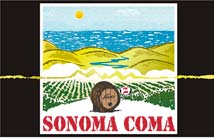 2007 george Sonoma Coma Russian River Valley Pinot Noir 13.9% alc., 90 cases, $50. The name of this wine comes from Aziz, the General Manager of Charlie Palmer · This is the lightest in color and weight of the lineup. Still, there is plenty of charm here with substantial aromas of cherries, herbs and rose petals followed by a good swath of cherry fruit in the mouth. Dreamy texture and feminine in style.
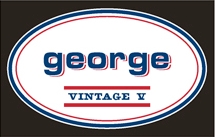 2007 george Ceremonial Vineyard Russian River Valley Pinot Noir 13.5% alc., 300 cases, $50. Formerly the Nuptial Vineyard, this vineyard is farmed by the Martinelli family. · Elegance personified with tasty red cherry, cola and spice flavors. Plenty of lively acidity on the finish pulls the drinker back to the glass.
2007 george Hansen Vineyard Russian River Valley Pinot Noir 13.6% alc., 85 cases, $50. This property was purchased by Fred Hansen · A more structured wine with a healthy attack of fruit on the palate. Earthy and a bit brambly and my least favorite wine in the lineup.
2007 george Leras Family Vineyard Russian River Valley Pinot Noir 14.5% alc., 85 cases, $50. Primarily Dijon clones with some Pommard. George says Vegas loves this wine. · Intoxicating aromas of fresh cherry and raspberry fruit. I wanted to dive in. Medium-weighted, with juicy sweet fruit that is perfectly ripe. Clean and lively on the finish. This is one I could snuggle up to.
2007 george King Family Russian River Valley Pinot Noir 14.1% alc., 85 cases, $50. 100% Pommard clone. · Relative light in color. This is a treat that begins with lovely crushed berry aromas and attacks the palate with tart cherry and berry flavors that are a little earth and cola toned. Supple tannins and no oak in sight.
2007 george Martaella Vineyard Russian River Valley Pinot Noir 13.9% alc., 85 cases, $50. All Pommard clone. Formerly named the Benovia Vineyard on Hartmann Lane off Piner Ranch Road. · The biggest daddy in the lineup offering luscious and creamy dark stone fruit with well-spiced black cherry aromas. A showoff that will appeal to hedonists.
George told me his experience with the 2008 vintage was similar to many other local vintners, with fruit ripening quickly due to heat at harvest. The resultant grapes were picked at higher Brix (24 to 26) and are darker in color and more concentrated than the 2007 vintage wines. These wines will be offered in the first part of next year. Visit the website at www.georgewine.com to sign up for the mailing list. 707-495-7783. If you are visiting in Healdsburg and happen to go to Charlie Palmer's to eat, don't be surprised to see george in his baseball cap and shorts holding court at the bar and drinking some good Pinot.
Cecil De Loach was a San Francisco firefighter when he and his wife Christine bought the Barbieri Ranch Vineyard in 1970. Located in the heart of the Russian River Valley on Olivet Lane, this 24-acre vineyard had been planted to Zinfandel in 1905. Shortly thereafter, they added another 27-acre vineyard close by where the De Loach Vineyards winery was built. By 1975, Cecil took an early retirement and devoted himself to winemaking. Over the years, De Loach acquired 900 acres in Sonoma County and was producing 250,000 cases of wine a year. The vineyard-designate Zinfandels were quite popular as was the White Zinfandel and Chardonnay wines. Pinot Noir was also a major part of production and De Loach even had a specific winery designed to produce Pinot Noir. In 2003, the label was sold to Boisset and Cecil and Christine started over in 2004 with a small family winery named Hook & Ladder located several miles away from De Loach on Olivet Road. Over 375 acres of vineyards were retained. Grandson Jason De Loach, who trained under Dan Cedarquist at Balletto Vineyards, became the winemaker in 2006. Several other family members are also involved in the small and unpretentious operation. There has been a renewed devotion to Pinot Noir and the most recent vintage wines have been very impressive. At the recent Sonoma County Harvest Fair, the 2006 Hook & Ladder Winery Estate Bottled Russian River Valley Pinot Noir won a Gold Medal in the $25 to $34.99 class and the 2006 Hook & Ladder Winery Estate Bottled Reserve won Best of Class in the $35 and over category.
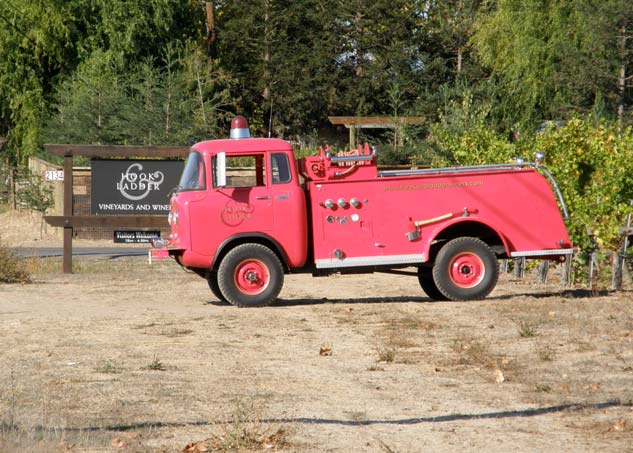
2006 Hook & Ladder Vineyards & Winery Estate Bottled Russian River Valley Pinot Noir 14.2% alc., 4,519 cases, $25. Made in small batches using open-top fermenters, native yeasts, 11 months in French oak barrels. · Moderately light crimson color. Pleasant scents of red fruit, oak and herbs, particularly sage, all of which are echoed in the flavors. The vein of savory herbs is particularly prominent. Light in weight and easy drinking, this wine is a perfect match for grilled salmon with thyme.
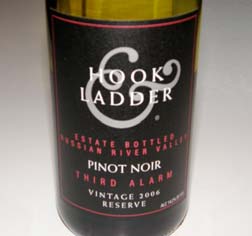 14.2% alc., 168 cases, $35. Whole berries and whole clusters, native yeasts, hand pigeage 3-4 times a day for 3 weeks, aged for 11 months in new and seasoned French oak barrels. · Deep and persistent scents of dark red fruits accented nicely with oak toast. Flavors of deep red to black Pinot fruits, cola and cedary oak fan out nicely on the palate. A seamless wine with a mild grip of tannin and a soft landing at the end. A seductive wine that is quite stylish.
Hook & Ladder Vineyards and Winery wines are sold on the website at www.hookandladderwinery.com. The tasting room is located at the Barbieri Ranch at 2134 Olivet Lane and is open daily from 10:00 to 4:30. 707-536-2255.
John Balletto started farming in Sonoma County at the age of 17 in 1977. Today he owns 280 acres in western Sebastopol devoted to wine grapes. 60 acres are planted to multiple clones of Pinot Noir. The western edges of his property are shared with the Laguna de Santa Rosa wetland habitat and are preserved lands. Balletto is a relative newcomer to wine production, launching the Balletto Vineyards label in 2001. At the recent Sonoma County Harvest Fair, Balletto Vineyards Pinot Noirs captured three Gold Medals. The winemaker is Dan Cedarquist, who was the winemaker at De Loach for 11 years before being replaced by Greg La Follette when Boisset bought the De Loach Winery in 2003. Balletto Vineyards is located at 5700 Occidental Road, Santa Rosa. The tasting room is open daily from 10:00 to 4:00. The tasting room is shared with Dutton-Goldfield wines which are made at the Balletto winery. The phone is 707-568-2455. The wines are sold on the website. The Balletto Vineyards Pinot Noirs are very sensibly priced.
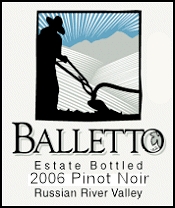 2007 Balletto Vineyards Russian River Valley Estate Bottled Pinot Noir 13.9% alc., $25. · An easy drinker featuring dark red Bing cherries, smoke and forest floor presented in a lighter style with soft tannins, a silky texture and a refreshing finish. Commendable balance.
2007 Balletto Vineyards Russian River Valley Estate Bottled Winery Block Pinot Noir 13.9% alc., $28. · Sensual aromas of confected berries, cherries and baking spices. Rich cherry liquor on the palate, nicely spiced, beautifully balanced, with gossamer tannins and a clean finish. Holds up in the glass nicely over time.
Balletto Vineyards wines are sold on the website at www.ballettovineyards.com. Balletto Vineyards is located at 5700 Occidental Road, Santa Rosa. The tasting room is open daily from 10:00 to 4:00 and is shared with Dutton-Goldfield wines. The phone is 707-568-2455. The Balletto Vineyards Pinot Noirs are very sensibly priced considering the quality.
I recently wrote an extensive feature in the PinotFile (Volume 6, Issue 63) on J Vineyards & Winery and their renewed commitment to their still Pinot Noir program. J Vineyards & Winery has considerably downsized sparkling wine production while retaining the excellence of these wines, and devoted more energies to Pinot Noir. New Pinot Noir vineyards have been acquired totaling 60 acres scattered throughout the Russian River Valley, estate vineyards have been at least partly redirected to still Pinot Noir production, and noted winemaker, George Bursick, formerly of Ferrano-Carano, has brought his 30 years of winemaking experience to J beginning with the 2006 vintage. During my recent trip to the Russian River Valley, I stopped in at J and spent a wonderful afternoon with George and the staff of J tasting through every Pinot Noir from the 2006 and 2007 vintages side by side.
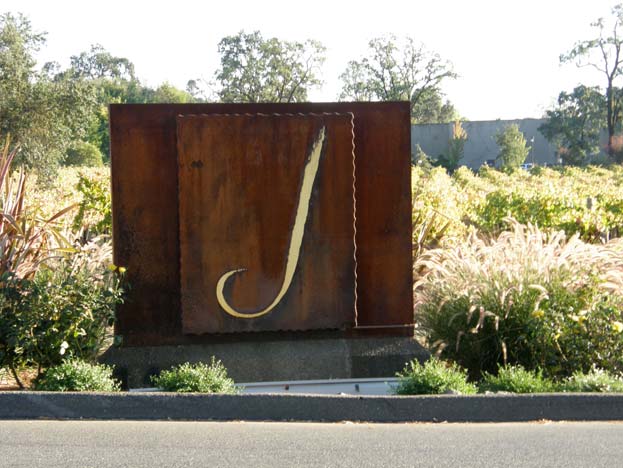 George is clearly enjoying the time of his life, having been given free reign to bring innovation to the winemaking program. Both the 2006 and 2007 vintages were vinified in the same manner. Both sides of the vines are striped two weeks before harvest to assure full ripening of phenolics in the grapes. Seeds are removed to minimize undesirable tannins. Burgundian yeasts dating to 1940-1945 are used (George is the only winemaker in California using these yeasts) and fermentations are unhurried. Secondary fermentations in barrel are long and slow lasting through the spring of each year. Extended post-fermentation macerations bring out color, flavor and desirable skin tannins. Normally, 30% to 35% new French oak barrels from five different coopers are used for aging. Target alcohol levels are 14.2% to 14.4%. The entire winemaking regimen is intended to be leisurely and natural. That old winemaker saw is very true at J: “Let the fruit speak.” George is a believer in diversity in the vineyard and in his wines. With 20 different vineyard sources and 84 different resultant wines to work with, he has the unique opportunity to craft Pinot Noirs of uncommon complexity. The workhorse of the J Pinot Noirs, the Russian River Valley blend, contains grapes from all reaches of the Russian River Valley, from Westside Road, to Forestville, to near Cotati. J is one of the few wineries in the Russian River Valley to have planted the newest Dijon clone, 943. Among the 2006 vintage releases, the Russian River Valley, Robert Thomas Vineyard and Nicole's Vineyard are still available. The 2007 wines will be released next year beginning in June and continuing through late August. My brief impressions are below. Obviously, the 2007 Pinot Noirs are still evolving, yet it is clear the vintage is stellar. The 2006 wines are more classic, while the 2007 wines are more showy. The one word that stuck in my mind at the end of the tasting was consistency. Each wine was beautifully crafted and although different in aromatic and flavor nuances, all of them brought a smile to my face. The wines have delicate color and will never be mistaken for many of the Burgeaux wines that are so prevalent in the California marketplace. J Russian River Valley Pinot Noir This is the winery's workhouse bottling with about 14,000 cases produced annually. It is widely available in the retail marketplace. The 2006 Pinot Noir is light in body featuring primarily red fruits accented by herbs, barnyard, and a touch of oak spice. The 2007 is spectacular in comparison, with bright cherry and berry fruit, savory herbs, baking spice, and a trace of oak all brought together with great verve on the finish. J Nonny's Vineyard Russian River Valley Pinot Noir This 70-acre vineyard is named for J owner Judy Jordan's grandmother. It is located a half mile from J. Swan Winery and adjacent to River Road. It is planted to clones 2A, 667, 777, and 828 and is a challenging site to farm. Both vintages display striking Bing cherry aromas and flavors with the 2007 vintage showing off more fullness and softness and a pleasing velvety mouthfeel. J Barrel 16 Russian River Valley Pinot Noir 16 barrels out of 500 are chosen for this special bottling. The 2006 vintage has an appealing red cherry scent with a sidecar of herbs and new mown hay. Very soft and elegantly styled. The 2007 vintage has a bit deeper and darker cherry fruit with great purity and vibrancy. J Robert Thomas Vineyard Russian River Valley Pinot Noir This vineyard is located on Westside Road across the street from Moshin Winery. The site is very cool and is planted to a Rochioli selection as well as Dijon clones 667 and 777. The 2006 wine is an earthy Pinot showing slightly raisined and herbed fruit with a subtle vegetal note in the background. George used more barrel toasting in 2007 to reign in the vegetal note. The 2007 wine shows purer cranberry and dried cherry fruit with more power and persistence. J Sonoma Coast Pinot Noir Clones 667, 777, 828. This bottling is clearly distinct from the other wines in the J lineup offering more low tone deeper colored fruit such as plum and more sinew and briar notes. The 2006 is a substantial wine but retains an appealing silkiness. It is a killer on the palate, saucy and lush, with many flavors chiming in such as black tea and mocha. The 2007 vintage is similar but adds more savory herbs to the mix and has a little more frisky acidity. J Nicole's Vineyard Russian River Valley Pinot Noir This vineyard looks across the Russian River at Rochioli Vineyard. It is planted in uplifted river bottom and is usually the first vineyard picked. Clones 2A, 115 and 667. This is the sexiest and most sensual wine of the lineup. Darkly colored, particularly the 2007 vintage. The palate is soft, plush, long and tasty. Vibrant with flavor and character, I could not choose between the two vintages. If I had to romance only one wine in the J lineup, this would be it. J Vineyards & Winery is located at 11447 Old Redwood Highway in Healdsburg. The winery also produces excellent Chardonnay, Pinot Gris and Brut, Brut Rosé, and Late-Disgorged Brut sparkling wines. Several tasting programs are offered, some with food pairings in the luxurious Bubble Room or alfresco on the J Terrace. 1-888-JWINECO. The wines are sold on the website, but the best way to obtain limited Pinot Noir bottlings is through one of three Club J wine clubs.
 2006 Arista Longbow Russian River Valley Pinot Noir 14.5% alc., $36. · Moderately light crimson in color. Very appealing aromas of fresh red berries, baking spices and a hint of oak vanillin. A gentle wine with admirable finesse offering red berry flavors that are lightly spiced with a silky texture and some finishing persistence. Very pinotypical.
2006 Barnett Vineyards Tina Maria Vineyard Russian River Valley Pinot Noir 14.4% alc., 1,180 cases, $34. Fiona and Hal Barnett founded the family estate on the top of Spring Mountain in 1983. Tina Maria Vineyard is located in the Green Valley sub-AVA of the Russian River Valley and is planted to Dijon clones. The winemaker is David Tate. · Medium reddish-purple color. A lovely wine that is cherry-driven with prominent oak from beginning to end. Moderately mouth filling and nicely balanced, but a bit too much oak char for my taste.
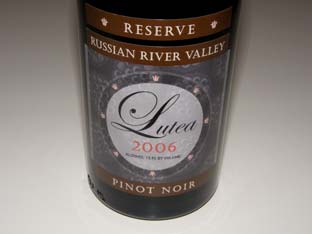 2006 Lutea Reserve Russian River Valley Pinot Noir 13.9% alc., $50. Aged 15 months in French barrels. Unfined and unfiltered. · A beautiful perfume of Bing cherries, rose petals, cardamon spice and fig. Lovely and ornate cherry and berry core with a hint of citrus peel on the finish. Powerfully flavored with some grippy tannins to shed, but retaining an admirable elegance. This will benefit from a year in the cellar. I have been a fan of Lutea Pinot Noirs and this one continues to fuel my enthusiasm.
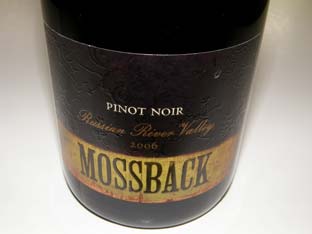 2006 Mossback Russian River Valley Pinot Noir 14.1% alc., $22. · Perfumed nose that is very floral with hints of black cherries, Moroccan spices, oak toast and Chanel #5. Dark stone fruits dominant on the palate. Mouth-coating tannins and a floral lift on the finish. Decent.
2006 Radio-Coteau Alberigi Vineyard Russian River Valley Pinot Noir 14.4% alc., $50 434 cases. This vineyard is located on Vine Hill Road. · Heady cherry liquor, anise and barnyard in the perfume. Earthy black cherry and black raspberry fruits accented by tar and rhubarb, with mild drying tannins on the finish. This is a good wine that grows on you and speaks of terroir.
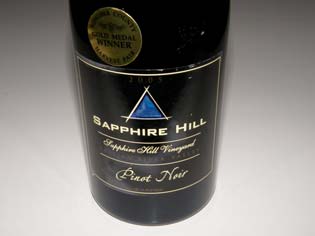 2006 Sapphire Hill Sapphire Hill Vineyard Russian River Valley Pinot Noir 14.4% alc., $32. Gold Medal winner 2008 Sonoma County harvest Fair. Unfined and unfiltered. · Complex nose of black cherries, cinnamon and cardamon spices, grilled fruit, herbs and a hint of pepper. Fresh and bright dark cherry core highlighted by oak which is prominent on the lively finish. Soft, smooth and tasty in the mouth. The wine was still drinking fine the next day from a re-corked previously opened bottle.
 2005 Scherrer Russian River Valley Pinot Noir 14.5% alc., $32. This wine comes from vineyards located in both Goldridge Series soils producing red fruit and orange peel components and clay soils offering deep black cherry flavors. Unfined and unfiltered. · Potent aromas of ripe cherries, cola, caramel and baking spices that are intoxicating and never fade or tire in the glass. Tasty black cherry flavor with soft tannins, well-integrated oak, and a tangerine peel tang on the refreshing finish. A wine with seamless texture that is immensely satisfying. Like a bimbo that draws you in with perfume and seduces you with silk. Fred Scherrer knows Pinot and his wines are always sensibly priced. The best Russian River Valley bottling ever for Scherrer.
 2006 Small Vines Wines Russian River Valley Pinot Noir 14.3% alc., 375 cases, $42. From three high-density planted vineyards (2722-3630 vines per acre, 2-3 lbs per vine). The Sloan Family manages several vineyards in Sonoma County as well as producing their own wine under the Small Vines label. Their motto is, “The smaller the vine, the better the wine.” Clones are Swan, 113, 114, 115, 667, 777, and 459. 7 day cold soak, native yeast fermentation, aged 15 months in 50% new French oak. This is their second vintage. · Alluring black cherry fragrance with subtle oak and a touch of good Pinot funk. Nicely composed and lighter-weighted flavors of cherries and cranberries with a hint of smoke. A touch of heat peaks out on the nose and finish. Not a penetrating wine, but one that offers admirable elegance and pinotosity.
Canihan Family CellarsThe Canihan family bought their 20-acre vineyard on the southern edge of the Sonoma Valley bordering Carneros in 1975, but planting did not start for 23 years. Bill Canahan, a second generation San Franciscan, had worked in Truckee and Tahoe City and was dismayed by the pollution that was damaging Lake Tahoe. When Bill, together with his father William Canihan, Sr., did initiate their vineyard planting, they were committed to farming sustainably and biodynamically. They were inspired by a member of the family, August Sieguist, who had sustainably farmed Pinot Noir and other cool climate varieties in his native Switzerland before immigrating to the United States in the early 1900s. The Canihans engaged viticulturalist Phil Coturri and winemaker Alexandra Romanini to assist them in producing estate Syrah, Cabernet Franc and Pinot Noir from their vineyard. The first Canihan Family Cellars release, the 2004 Estate Syrah, won Best Red in Show at the prestigious 2007 San Francisco International Wine Competition. The Canihan Family Cellars 2005 “Exuberance” Pinot Noir won Gold Medals at the 2008 San Francisco Chronicle Wine Competition and the 2008 West Coast Wine Competition. Quite an impressive resume for a very young winery. The Pinot Noir portion of the estate vineyard is 3.75 acres planted to Dijon clones 115, 667 and 777. Dryfarming and cane pruning result in small yields (less than 2 tons per acre). The vineyard receives the full impact of the cooling fog and maritime breezes from the nearby San Francisco Bay. The vineyard is certified organic by CCOF. Canihan Family Cellars was one of Crushpad’s (a custom crush facility in San Francisco) first commercial customers. Winemaking is traditional with a four day cold soak, native yeast fermentation in open-top tanks, minimal handling and a single racking into Francois Freres barrels. The wines are unfined and unfiltered.
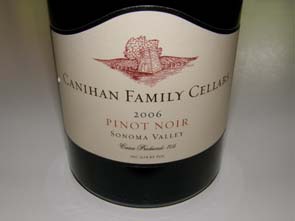 2006 Canihan Family Cellars Alexandra’s Reserve Sonoma Valley Pinot Noir 14.5% alc., 705 cases. · With coaxing, scents of dark red stone fruits, herbs, wildflowers and sawn oak emerge. A little more restrained than the 2004 vintage, displaying dark-hued fruits that are nicely spiced and oaked. All silk and satin. A subtle green note should resolve with further time in the bottle. This one will only get better with some aging.
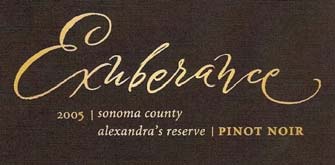 2005 Canihan Family Cellars Exuberance Aleandra’s Reserve Sonoma Valley Pinot Noir 13.7% alc., 200 cases, $60. Aged 12 months in 25% new Francois Freres oak barrels. · Deep reddish-purple in color. Subdued but pleasant dark jammy fruit with a touch of smoke on the nose. Muscular, dark plummy fruit with a touch of herbs and deft oak accent. The fruit is fully ripe, reminding me of eating perfectly ripe Pinot grapes in the vineyard at harvest. Smooth, clean and plush with supple tannins and admirable balance. This wine will appeal most to lovers of powerfully flavored, fruit-driven Pinots.
2004 Canihan Family Cellars Alexandra’s Reserve Sonoma Valley Pinot Noir 13.8% alc., 25 cases, $65. All estate grown, 40% 667 and 777, 20% 115. Yields less than 1.5 tons per acre. Aged 16 months in a French oak barrel. Produced at Crushpad. · Starts off strong with lovely aromas of dark stone fruits, herbs and a touch of barnyard. With time in the glass, the fruit aromas fade with more oak char and prune surfacing. The attack is rich with dark fruits, earthiness and a little oak char. Smoothly textured with admirable fullness, and a dry finish.
Canihan Family Cellars Pinot Noirs are available in several fine San Francisco Restaurants and Northern California retailers. The wines may be obtained directly from the winery by phoning 415-929-8190 or consulting the website at www.canihanfamilycellars.com. Production will always be small (less than 2,500 cases for all varieties). Tasting is available by appointment.
Recently Published Wine Books of Interest
A Comprehensive Winery Guide for Consumers and Connoisseurs John Winthrop Haeger has published a companion to North American Pinot Noir published in 2004. North American Pinot Noir is the bible of Pinot Noir and won the 2005 Louis Roederer International Wine Book of the Year Award. Pacific Pinot Noir is not a sequel, but a completely different book. While North American Pinot Noir focused on the European origins and history of Pinot Noir in the New World, growing Pinot Noir, definitive explanations of Pinot Noir clones and comparisons of New World Pinot Noir to Burgundy, Pacific Pinot Noir is devoted to extensive vignettes of Oregon and California Pinot Noir producers. The first publication contained 72 winery profiles, but Pacific Pinot Noir updates those profiles and adds many others totaling 216 prominent Pinot Noir producers. Obviously, not every notable producer could be included and some were omitted for reasons of unavailability of winery principals or their non-responsiveness.
 The wineries chosen for this comprehensive book all come from what Haeger terms the “Pacific Pinot Zone,” that region where Pinot Noir thrives from the mouth of the Columbia River in the North to the Santa Barbara Channel in the South, extending inland no more than approximately 25 miles from the Pacific Coast. The wineries were chosen based on their reputation, their frequent occurrence on Pinot-friendly restaurant wine lists, and their appearance on retail shelves where wines are carefully evaluated and chosen by a well-informed staff. After an initial introduction that delves into the current state of North American Pinot Noir, Haeger details each winery including its history, the story of its principals, a summary of vineyards owned or sourced and the wines produced, annual case production, winegrowing and winemaking protocols, wine style and extensive tasting notes. New producers, those of historic interest and the author’s personal favorites are identified. There are helpful black and white maps of AVAs, extensive contact information, and summaries of distribution. Year by year profile of vintages and a glossary of pinot terminology are also included. This is a valuable and well researched reference that belongs on every pinotphile’s desk. There is considerably more information on wineries than one will discover from researching winery websites. The book is compact enough to easily accompany the traveler on wine region explorations. University of California Press, Berkeley, paperback, 454 pages, 2008, $21.95.
Your Complete Guide to Understanding, Selecting and Enjoying Wine
 The three authors, Steven Kolpan, Brian H. Smith, and Michael A. Weiss, are very knowledgeable Professors of Wine Studies at the Culinary Institute of America. This is a general book on wine that is primarily directed at novices who will value it as a reference and a learning tool. It is a large, hard bound book that would look handsome in a library or on a family room table. Chapters cover an introduction to the various wine varietals and winemaking, wine and food matching, wine lists, bottle closures, and hosting at-home wine tastings. All the major wine producing regions of the world are discussed. Emphasis is placed on finding good wine values using a conscientious search and great inexpensive wines of the world are listed in a chapter titled, “Bargain Choices.” The authors also include their favorite wines. There are detailed color maps and numerous color labels with instructions on interpretation. The book is not completely current in all matters (Emeritus Pinot Noir in the Russian River Valley is named Goldridge - their outdated original name), and there is little coverage of boutique and newest producers. The bargain list of wines that is included could be a helpful guide for shoppers, but it is difficult to carry this heavy volume to a wine retail store. The book really breaks no new ground that hasn’t been covered in many other general wine books currently in print, but WineWise would make a welcome gift at Christmas for newcomers to wine. John Wiley & Sons, Hoboken, New Jersey, hardcover, 350 pages, $29.95.
This unique and entertaining work collects over fifty poems about wine from Joseph Mills, co-author of A Guide to North Carolina’s Wineries. Mills is a highly educated teacher of writing and Humanities courses in the Undergraduate Academic program at the North Carolina School of Arts. A number of the poems have previously appeared in literary and wine journals. The poems reflect the personal experiences of the author while traveling through North Carolina, talking to winemakers and winery owners. Often slyly humorous and at times ribald, Mills creates poems that make light of the nonsensical pomp and circumstance of wine. These titles of the poems give you a taste: “A Corkscrew is an Instrument of Optimism,” “Why You Should Have Your Date Open the Bottle,” and “Some Hypotheses about Why the Second Glass May Taste Better.” Angel’s share of course is the wine in oak barriques that gradually disappears due to evaporation. Mills writes in his poem, “Some Questions about the Drinking Habits of Angels”:

How do the angels Grab a glass of good Pinot, start with the poem, “No More Merlot,” and progress through the pages, savoring every verse. Reading about wine can be interminably boring, but reading this wine poetry will leaving you smiling.
Press 53, Winston-Salem, North Carolina, paperback, 87 pages, 2008, $12.00. Read more about the author
and his work at www.josephrobertmills.com.
These three books are available from the publishers, book retailers and amazon.com.
The Sideways Effect The American Association of Wine Economists recently published a research paper at www.wine-economics.org written by Steven Cuellar and Dan Karnowsky of the Department of Economics at Sonoma State University. This paper examined the effects of the movie ‘Sideways’ on United States wine consumption of Merlot, which is derided in the movie and of Pinot Noir, which is praised. ‘Sideways’ was released on October 22, 2004, and worldwide sales were just over $100 million, making it the 40th highest grossing movie of the year. The results of the study showed that the movie ‘Sideways’ had a small negative impact on the consumption of Merlot while increasing the consumption of Pinot Noir. The positive impact on Pinot Noir was greater than the negative impact on Merlot. After the movie’s release, the price of Merlot decreased, while the price of Pinot Noir increased. In addition, the paper indicated that there was a general increase in wine consumption due to the movie’s popularity.
O’Connell Vineyards & Vine Hill HouseThe O’Connell family came from County Cork, Ireland and settled in the Sebastopol area in the early 1900s. They began apple farming in 1913. James E. O’Connell purchased the land in 1935 on which the O’Connell Vineyard and Vine Hill House stands today. O’Connell Ranches is still a working apple ranch, vineyard and guesthouse operated by Dan O’Connell and his wife, Jan, who is also a native of Sonoma County. In the Russian River Valley, apples and grapes are symbiotic, with vineyards thriving next to or in place of former apple orchards. The estate is beautifully situated in the Vine Hill area of the Russian River Valley with panoramic views of Mount St. Helena to the North, the Coastal Mountain Range stretching south to the Bay Area, and the adjacent Laguna Ridge Vineyard, acquired from the O’Connell family by E. & J. Gallo several years ago. The Vine Hill House is a unique and cozy guest hideaway. It consists of two bedrooms and two bathrooms, sleeping six, with all valued amenities. The Vine Hill House and grounds are perfect for business functions, weddings, vacations and private functions. For information or reservations, consult the website at www.vinehillhouse.com. Dan and Jan will make your stay or event memorable.
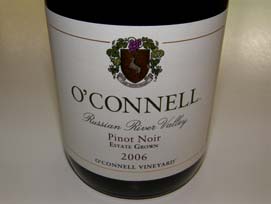 2006 O’Connell Vineyards Estate Grown Russian River Valley Pinot Noir 14.2% alc., 268 cases, $42.50. 100% Pommard clone. 100% de-stemmed, sur lie aged in barrel for 10 months. · Light crimson color. Reserved scents of cherries, Provencal herbs and new oak. Red-fruited with savory herbal tones. Smoothly textured and elegant with supple tannins and a leafy-flavored finish.
O’Connell Pinot Noir and Rosé are available on the website at www.oconnellvineyards.com. 888-889-0929. |